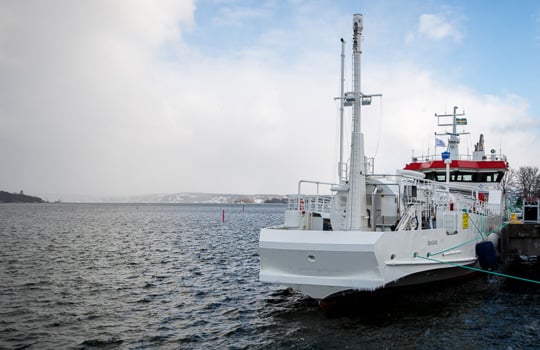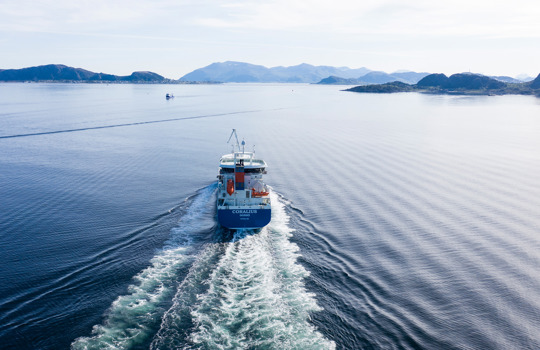What are the advantages of liquefied biogas as maritime fuel?
Liquefied natural gas (LNG) technology allows for an easy transition to use renewable and low-emission liquefied biogas (LBG). With the possibility of blending LBG into LNG, you are able to determine how much to utilize it and when. There are plans to extend the principles of circular economy to shipping and to produce biogas from ship-generated biowaste and grey-water.
The possibility of using LBG on LNG-powered vessels allows much more flexibility than conventional fuels and the biomass mixed with them. Switching from conventional fuels, diesel and low-sulfur fuel oil, to LNG brings along a 20% reduction in CO₂ emissions, an advantage compared to any oil-based products. In this case, adding even small amounts of biogas in the mix, much more can be achieved than by adding biodiesel to oil-powered vessels.
“Reducing emissions, that’s the starting point. Increased volumes of biogas offer considerable opportunities for this. LNG-powered vessels will be able to reduce their emissions even more by using biogas,” says Jacob Granqvist, Vice President of Maritime.
Blending LNG and LBG is the first step: Gas infrastructure is compatible with future fuels
A cleaner energy solution already, the LNG infrastructure also enables the use of LBG, which takes the emission reduction to a whole new level.
Switching to LNG from oil means complete removal of SOx (sulfur oxides) and particles, and reduction of NOx (nitrogen oxides) emissions of up to 85 percent. In addition, LNG reduces CO₂-emissions by at least 20 percent compared to the conventional fuels, whereas LBG can reduce CO₂-emissions up to 90 percent.
LNG and LBG are methane, they are the same molecule. When mixing these gases, there are no compatibility issues. When blending conventional fuels with biofuels produced from agricultural crops, the mix doesn’t come that easy.
Production volumes of biogas as well as biofuels like biodiesel, have increased significantly in recent years. As the demand grows, questions of availability and sufficient volumes have also increased.
“The demand for biodiesel, and the spectrum of its applications is much broader than that of biogas. This leads to a situation where it is reasonable to question whether there will be enough biodiesel to satisfy the growing demand for all sectors. For example, biodiesel is one of the key opportunities for the aviation industry to reduce emissions,” Granqvist says.
Gasum’s goal is to bring 7 TWh of renewable gas yearly to market by 2027 – saving 1.8 million tons of CO₂ emissions.
Blending LBG to LNG is the first step, but the infrastructure allows for more. The methane gas infrastructure is future-proofed, since synthetic gas, power-to-gas and other solutions are entering the market. Thus working as a bridging fuel for several future solutions such as synthetic LNG.
Additional biogas costs can be allocated according to needs
LNG customers can run their ships on LNG alone, or they can mix in a percentage of LBG if they wish. The mixing ratio can be anything between zero and one hundred percent, there are no technical limitations to it.
Another option is to buy LBG in targeted batches, which will be utilized according to the situation.
“We can allocate a hundred containers of liquefied biogas to our customers, for example. They are then able to allocate this emission reduction to specific cargoes or passengers. Let’s say, a group of cruise passengers want to carbon neutralize their journey. The shipping company can allocate the additional cost of the biogas to its customers, who are willing to pay for this emission reduction,” Granqvist says.
Large companies have a high ambition level to reduce their CO₂ emissions. LBG allocation can be used to target reductions to specific transports. For example, when specific batches or product groups are shipped from Northern Europe to Central Europe.
“A shipowner could experience higher costs when deciding to blend 10% of LBG into his LNG. The resulting additional cost is difficult to allocate forward. Some are willing to pay for this, some are not. For this reason, it is better to allocate in batches and give the opportunity to those who are willing to pay for it,” he adds.
Circular economy at sea: Collecting bio-waste from ships to biogas production reduces emissions
The poor and vulnerable condition of the Baltic Sea is a well-known issue in the countries surrounding it. The range of measures and actions to reduce nutrient load and oxygen loss are constantly being developed and expanded. Gasum has also taken action in discussions with its customers, and with the Baltic Sea Action Group.
“We have discussed with our shipping customers on taking their biowaste, as well as their grey water. From these waste streams we are then producing biogas that we can supply back to them as fuel. Such opportunities exist and we are currently planning them in more detail,” Granqvist reveals.
The amount of waste from the ships would not yield enough biogas to power them completely but would increase the value of ships’ bio-waste and reduce nutrient emissions in the Baltic Sea. This would not bring any additional costs to the companies, as they already pay a waste fee in ports. Everyone would win.
“This adds to the entire value chain and extends circular economy thinking to shipping as well. Not only cruise ships, which produce more bio-waste and grey water, but ordinary cargo ships will be included in this network as well,” he says.
When launched, the project will be piloted in Finland, but can later be scaled to other markets as well.



